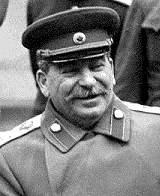Secret documents reveal Stalin was poisoned
December 21 was the 126th birthday of Soviet leader Joseph Stalin. Historian and publicist Nikolay Dobryukha says the Kremlin archives contain documented evidence proving that Stalin was poisoned.
The discovered documents absolutely disprove all affirmations saying that Stalin died of cerebral hemorrhage caused by his poor health. These documents are the records of Stalin's medical examination within the period of over 30 years. These documents also demonstrate that Stalin was not at all apprehensive of medical examinations and was not afraid of receiving treatment of doctors as it was rumored. It was also said that for fear to visit doctors Stalin often resorted to self-medication. In fact, highly-qualified doctors were called for in case of Stalin's slightest indisposition and had close medical examination of the high-ranking client all day round. 
Records made in September 1947 state that Joseph Stalin had initial stage hypertension, also chronic articular rheumatism and overfatigue. Doctor Kirillov made a record of Stalin's blood pressure – 145 per 85 – which was excellent for his age of 67 at that time.
At the age of 70, Stalin's blood pressure made up 140 per 80 and the pulse made up 74 beats per minute before taking bath. After the bath, blood pressure dropped to 138 per 75 and the pulse made up 68 per minute. The Soviet leader did not complain of bad sleep, had regular bowel movements and was fine in general. The medical records show Stalin had the blood pressure of 140 per 80 and the pulse 70 beats per minute at the age of 72. At that, the latter measuring was made when Stalin had flu and fever. It is unlikely that younger and healthier people can register similar showing. And this is astonishing that no other medical record mentions of the initial stage hypertension of Stalin.
It was not true when some people stated that “Stalin was seriously ill, especially after the dramatic stress he endured during WWII”. These talks appeared as soon as bulletins about Stalin's health were published for the first time on March 4, 1953. These official bulletins stated that on the night of March 2 Joseph Stalin had cerebral hemorrhage caused by his hypertension and atherosclerosis.
The false statements were encouraged by Lavrentiy Beria and his protйgйs Malenkov and Khrushchev as soon as they became leaders of the country.
The discovered documents reveal that the Soviet leader got poisoned within February 28 – March 1, 1953, between the Saturday night and Monday, the period when majority of doctors cannot be reached for because of their day off. That was done on purpose to give the poison enough time to take effect.
But it is not also ruled out that conspirators first immediately poisoned Stalin and only after that his double fell victim of the poison as well. In fact, Beria did not expect the poisoning would be so protracted and that is why he felt incredibly nervous. On March 4, newspapers controlled by Beria reported that “Stalin had cerebral hemorrhage staying in his Moscow apartment on the night of March 2” which was not true because Stalin died at the out-of-town residence. Why did Beria need to report the leader died in his Moscow apartment? Probably he spread misinformation to use Stalin's look-alike: maybe Stalin died immediately after poisoning staying in the out-of-town residence and his double “fell ill” in an instant in the Kremlin and then on the night of March 2 was moved to the out-of-town residence to substitute the already dead Lord. In a word, Beria's plan turned out to be not quite smooth. To be on the safe side, when it was publicly announced Stalin was dead Beria still arrested the head of a laboratory making poisons for secret killings.
Many people knew that Beria was going to wage war against Stalin. His son Sergo said that father highly likely schemed something against Stalin with the help of his supporters in law enforcement structures and with his own intelligence structure that was not controlled by any of the governmental structures.
Stalin's bodyguards say that the leader got poisoned immediately after he drank mineral water. Indeed, Stalin was found dead lying near a table on which a bottle with mineral water and a glass stood. The poison took effect instantaneously. Some sources state that Stalin fell down dead and others insist he fell down unconscious.
Study of the archives revealed that on November 8, 1953 the Kremlin sanitary department wanted to hand “medicaments and three empty mineral water battles” over to the Stalin Museum. But for some reason, the department handed just two empty bottles to the Museum on November 9. What is the secret of the third lost bottle?
The journal kept by doctors treating Stalin brings to nothing the memoirs and researches of Stalin's last illness and death. As seen from the records in the journal the doctors obviously understood that Stalin was poisoned. This is proved by prescriptions they made: ice application to the head; sweet tea with lemon; catharsis with sulfur-acid magnesia and so on.
When doctors examined Stalin at 7 a.m. March 2 they found the patient lying on his back on a sofa with the head turned to the left and the eyes closed. The hyperemia of face was moderate; the breathing was not upset. The pulse made up 78 beats per minute, the heart sounds were rather muffled. The blood pressure made up 190 per 110. The stomach was soft and the liver protruded 3-4 cm from under the rib edge. Stalin was unconscious; his condition was grave.
Doctor Lukomsky discovered that Stalin's right arm and leg were paralyzed. From time to time his left leg and arm moved a little. The medical records suggest that doctors did their best to treat the leader for poisoning and for its consequences, blood supply disturbance and insult, at the same time. But none of them pronounced that was poisoning.
It was on March 3 when Stalin's doctors registered that condition of the patient grew even worse and heart activity got weaker. Next day, March 4, the condition of the patient grew extremely grave because of frequent respiratory standstills. Suddenly, the skin on the face, legs and arms became blue which is quite typical of poisoning with some poisons. When a human organism is poisoned with aniline, nitrobenzene and others hemoglobin turns into methemoglobin having dark color. It is not ruled out that Stalin was poisoned with a mixture of different poisons.
On the night of March 5, doctors got results of Stalin's blood and urine tests which indicated the patient suffered from poisoning. But the doctors were afraid to tell Beria about poisoning as they feared he would blame any of them for the poisoning. Stalin's liver was still enlarged, another factor typical of poisoning.
Early in the morning March 5, Stalin had bloody vomit as a result of which the pulse declined and the blood pressure dropped. The doctors were at a loss how to explain what was happening to the patient. All day long Stalin had bloody vomit and was in collapse several times.
In the evening on March 5, Stalin was wet through with perspiration, the pulse was thready and cyanosis intensified. The doctors gave the patient carbogene several times but the condition did not improve. At 9:40 p.m. Stalin had artificial ventilation but in vain. His death was registered at 9:50 p.m.
Many of documented evidence left by doctors, including premortal examination of Stalin, disagree with recollections of other eyewitnesses. For instance, Stalin's daughter Svetlana said she could not recognize the father as his illness changed him beyond recognition. Was it possible that Beria's people substituted Stalin with his double and even his relatives could not recognize him?
One of the documents pertaining to Stalin's death discovered in the Kremlin archives seems to be particularly mysterious. The document says that nurse Moiseyeva gave Stalin an injection of calcium gluconate at 8:45 p.m. Never before that over the whole period of illness was Stalin given such an injection. At 9:48 p.m., the nurse affixed her signature to a document revealing she gave Stalin an injection of 20-percent camphor oil. Finally, the woman made an injection of adrenalin to Stalin for the first time over the whole course of treatment and made an official record of the fact. Soon after that the Soviet leader died. This coincidence probable gave rise to rumors that a Jewish woman trained by Beria dispatched Stalin to the next world by giving him a special injection.
When contemporary doctors studied medical records of Stalin's illness and last hours of life they stated adrenaline injections were forbidden for patients registering the same symptoms that Stalin had.
But it is a fact that soon after Stalin's brothers-in-arms distributed authority at a special plenary session in the Kremlin, they came to the out-of-town residence where Stalin was still staying alive and gave him the fatal injection.
Subscribe to Pravda.Ru Telegram channel, Facebook, RSS!





